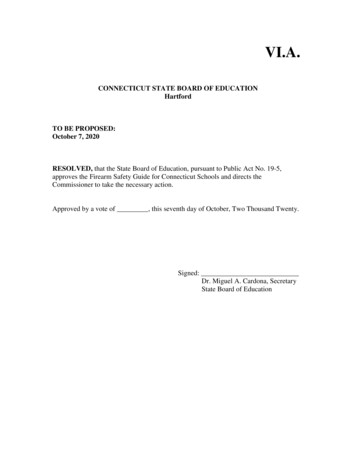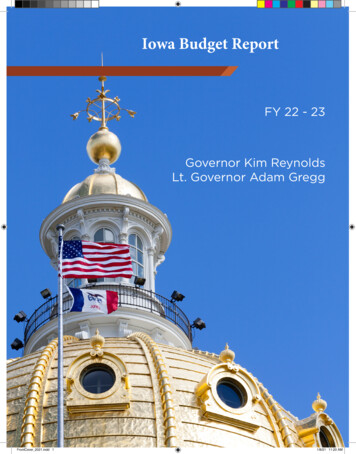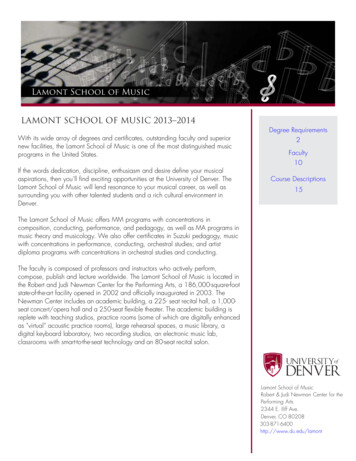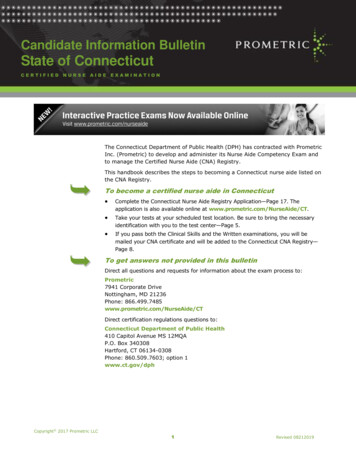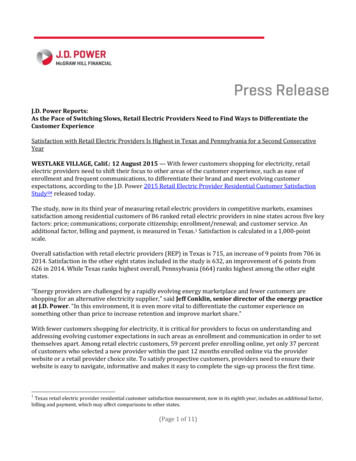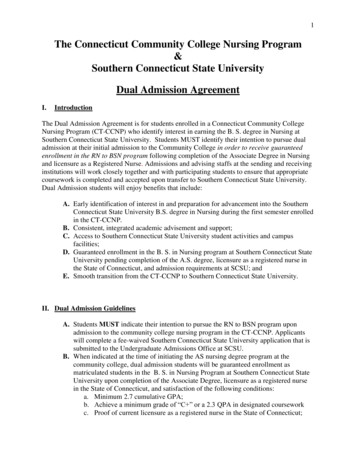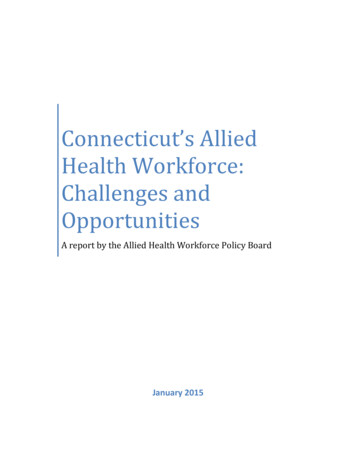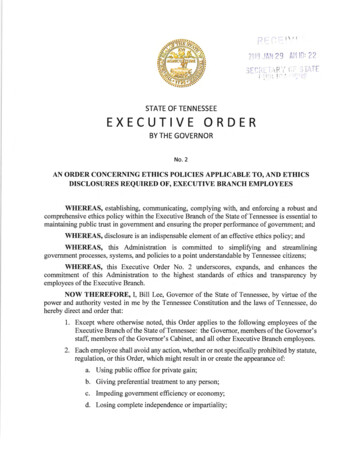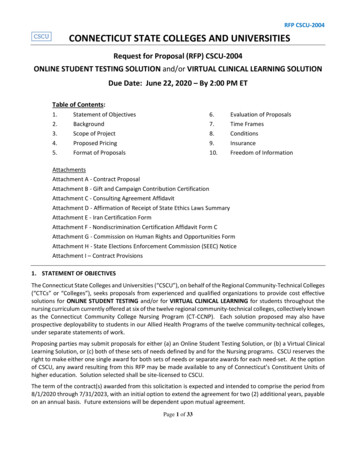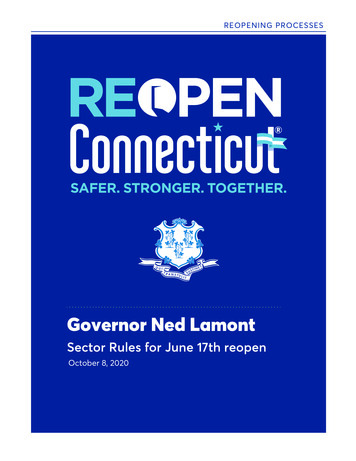
Transcription
REOPENING PROCESSESGovernor Ned LamontSector Rules for June 17th reopenOctober 8, 2020
GUIDING PRINCIPLESSECTOR RULES FOR JUNE 17TH REOPENGOALProactively protect public health and speed up the pace of economic, educational, andcommunity recovery while restoring Connecticut’s quality of life.12345 1 SAFETY FIRSTWe will reopen society safely and securely with a proactive program thatsafeguards the health of our vulnerable residents, continues physicaldistancing, and provides clear safeguard rules for businesses andinstitutions deemed safe to reopen.SCIENCE-DRIVENOur strategy will rely on a scientifically validated set of public healthinterventions. Patient assessment, testing, proactive tracing, field studies,and public health guidance will be deployed simultaneously tocontain infection.PREPAREDWe will work closely with hospitals and health systems to procure anddistribute critical personal protective equipment, and assess capacity ofbeds and ventilators to ensure optimal standard of care.CHOICEIndividual businesses within sectors allowed to open are empowered tomake their own choice on when they reopen. When they open, they mustcomply with rules we lay out to safeguard their employees and customers.DYNAMICWe include a suite of tools to inform an adaptive plan that can benimbly scaled or rolled back rapidly based on real-time criticalhealth metrics.
GUIDING PRINCIPLESSECTOR RULES FOR JUNE 17TH REOPENHO W WE WI L L OPE N OU R E C ONO M Y S A FE LYOur plan to open the economy will address two factors:WHAT businesses can open and when.HO W businesses must operate i f th e y c h o o s e t o o p e n .WHAT : We know that some businesses put employees and customers at greaterrisk of transmission. We will prioritize opening businesses that pose a lower transmission risk and driveoutsized impact on the economy. Transmission risk is defined as contact intensity and modification potential of businesses.- Contact intensity considers contact proximity, contact length, and number of contacts.- Modification potential considers the businesses’ ability to socially distance andsanitize in accordance with regulations. We will assess the impact on state economic health with a focus on number ofemployed individuals, total GDP impacted, and impact on small businesses thatmake up the backbone of our economy.HO W: We will provide clear operational guidance to businesses on how to reopen whileensuring the safety of both employees and customers. Guidance will include social distancing and hygiene, as well as the use ofpersonal protection – for business operators, workers, and customers. The goal is to not only open safely, but create confidence in our society acrossemployers, employees, and customers. The level of guidance will gradually become less restrictive over time, as ourconfidence in the ability to monitor and contain the disease increases. 2
GUIDING PRINCIPLESSECTOR RULES FOR JUNE 17TH REOPENWHAT : SE C TOR R E OPE N I N G OV E R T IM EThe state w i l l o p e n i ts e cono m y w i t h a gr a dua l a p p r o a c h .The first set of businesses started reopening when we saw a sustained 14-day decline inhospitalizations, had adequate testing capacity, had a contact tracing system in place, and hadprocured sufficient PPE. The timing for that reopen was May 20th.ALWAYSOPENManufacturingChild careConstructionHospitalsReal estateUtilitiesEssential retailMAY20 T HJUNE1S TRestaurants(outdoor only,no bar areas)Outdoor recreation(limited capacity)Hotels/LodgingAll personalservicesIndoor recreationJULY20TH 3 Offices (continueWFH where possible)Museums, Zoos(outdoor only)University researchHair salons,BarbershopsRestaurants(outdoor, indoor,no bar areas)JUNE17THRemaining retailIndoor eventsSports, Sportsclubs &complexes, Gyms,Fitness centers,PoolsOutdoor arts,Entertainment,Events (limitedcapacity)AmusementparksLibrariesMuseums, Zoos,AquariumsSocial clubs
GUIDING PRINCIPLESSECTOR RULES FOR JUNE 17TH REOPENHO W: SAFE G U AR DSAs we continue to reopen businesses on June 17th, we will open at our strictest controls onbusiness operations and societal interaction. This will include, among other measures: Capacity limit of 50% for most businesses that reopen. Strict cleaning and disinfection protocols in all settings. Those who can work from home should continue to do so. Those in high-risk groups (comorbidities) and over the age of 65 should continueto stay safe and stay home. Facemasks should continue to be worn in public at all times. Social gatherings will be restricted in accordance to the Governor's executive order.As we see progress on a defined set of public health metrics (detail to follow), we will graduallyloosen safeguards. This will allow for the next set of businesses to open and potentially forbusinesses already open to operate with additional leeway. We expect this will occur over thecoming months.As always, we will make decisions based on data and science. Our plan intentionally allows forsufficient time for learning, adoption of behaviors, and ultimately the achievement of improvedhealth metrics that create the necessary environment for new business operations. If publichealth metrics deteriorate, the State may choose to revert back to stricter safeguards. 4
REOPENING PROCESSESLIBRARIESLibraries can open at up to 75% capacity inthe current phase of reopening.
INTRODUCTIONLIBRARIESOVERVIEWAs Connecticut's libraries reopen, the most important consideration will be the health and safetyof employees and patrons. Libraries must exercise caution throughout the reopening, ensuringstrict adherence to the protocols listed here. Those libraries that are not able to meet the ruleslisted here shall delay opening until they are able.While these rules provide a way for libraries to reopen in as safe a manner as possible, risks topatrons and employees cannot be fully mitigated. Patrons who choose to visit libraries duringthis time should be fully aware of potential risks. Individuals over the age of 65 or with otherhealth conditions are advised to not visit libraries, but instead continue to stay home and staysafe.Libraries should take these rules as the minimum baseline of precautions needed to protectpublic health in Connecticut. The CT State Library Division of Library Development may issueadditional documents to help libraries in designing their roadmaps to reopening and recovery.The American Library Association (ALA) has compiled extensive resources to help librariesaround the country to reopen. We suggest libraries refer to ALA's resources in planning theirreopening process. These rules may be updated as conditions evolve.We urge patrons to stay vigilant and pay attention as to whether libraries they visit are faithfullyimplementing these rules.FURTHER RESOURCES unity/disinfecting-building-facility.html AMERICAN LIBRARY eopening-resources INSTITUTE OF MUSEUM AND LIBRARY openingpractices-libraries CT STATE OVID-19/ f 6
REOPENING PROCESSESLIBRARIESPLAN FOR R E OPE N I N GShare these rules with your employees and inform them of any additional specificmeasures being taken in response to COVID-19.PROGRAM ADMI N I S TR ATORAppoint a program administrator who isaccountable for implementing theserules. Program Administrator should belibrary staff.C LE A N IN G P LA NDevelop cleaning checklists thatincorporate these rules. Ensure it is clearwhich employees are responsible forimplementing the plans.TRAI N I N GThe employer shall institute a training program and ensure employee participation in theprogram. Training shall be provided at no cost to the employee and during working hours. Thetraining materials shall be presented in the language and at the literacy level of the employees.Employers shall continuously update staff on changes to these Sector Rules. The training shallinclude: Guidelines outlined in this document Protocols on how to clean and use cleaning products (incl. disinfectants) safely Additional guidance can be found es/documents/FactSheet Cleaning Final UWDEOHS 0.pdfNOTE: If any on-site duties are subcontracted, it is the employer’s responsibility to ensuresubcontractors are also appropriately trained.PERSO N AL PR OTE C TI ONEstimate required personal protection for employees and begin procuring. 7
REOPENING PROCESSESLIBRARIESTHOROUG H C L E AN I N GComplete a thorough cleaning of facility prior to reopening, including but not limited to: Bathrooms Seating area Computer stationLO G EM PLOYE E SMaintain a log of employees on-premiseover time, to support contact tracing.S HIFT SStagger shift start/stop times and breaktimes to minimize contact acrossemployees.REM O TE WOR KConsider offering employees whose responsibilities can be met in a remote work setting theability to continue to work remotely.CAPACI T Y TR AC K I N GLibraries are responsible for enforcing revised capacity limits.CERTI FI CA TI ONComplete the self-certification on the DECD website to receive a Reopen CT badge. Oncecomplete, businesses can choose to post the badge on-site and on social media to advertiseadherence to CT rules. 8
REOPENING PROCESSESLIBRARIESConsider waiving fines and extendingdue dates to discourage patrons fromcoming into the library in-person.Libraries should consider waysto maintain social distancingin aisles between book stacks,including signage to directtraffic patterns, limiting thenumber of patrons allowedin stack areas, or providingaccess to materialsby staff retrieval.Post clear signage thatreinforces new policies.Install physicalbarriers aroundthe circulation desk.Block off every other computerterminal or every third toensure 6 ft of social distancing.Consider encouraging patronsto use book drops to returnbooks instead of returningin-person at circulation desks. 9 Consider an exit from the facilityseparate from the entrance toallow for one-way foot traffic.
PHYSICAL SPACE SETUPLIBRARIESCAPACI TY L I MI TCalculate a maximum occupancy that isconsistent with social distancingguidelines or 75% of library's fire codecapacity, whichever is lower. For periods of time where high trafficis expected, post guards at entranceto count and monitor total numberof patrons inside the library.I N -PERSO N S E R VI C E SConsider limiting in-person services offered,such as the reference desk. Insteadencourage patrons to send questions byemail and phone to be answered bylibrarians remotely. Consider continuing to offer alllibrary programs virtually. All in-person programs, such asworkshops or job fairs, must followthe prevailing limitation on size ofsocial gatherings. Desks and chairsmust be arranged so that 6 ft socialdistancing is observed at all timesduring workshops.CI RCULAT I ON DE S KInstall physical barriers around thecirculation desk.FIN E S & D UE D A T E SConsider waiving fines and extending duedates to discourage patrons from cominginto the library in-person.BOOK DROPConsider encouraging patrons to usebook drops to return books instead ofreturning in-person at circulation desks. Books returned to the library willbe quarantined for at least 48 hours(or intervals based on researchapproved by the CDC and IMLS).B O O K S T A CK SLibraries should consider ways tomaintain social distancing in aislesbetween book stacks, including signageto direct traffic patterns, limiting thenumber of patrons allowed in stackareas, or providing access to materialsby staff retrieval.CO M P UT E R T E R M IN A LSBlock off every other computer terminalor every third to ensure 6 ft of socialdistancing.EN T RY & E X I TConsider an exit from the facility separate from the entrance to allow for one-way foot traffic. 10
PHYSICAL SPACE SETUPLIBRARIESSI GN AGEPost clear signage that reinforces newpolicies, e.g.: Social distancing protocols Cleaning and disinfection protocols Personal protection protocols(face masks) Employees should stay home ifsick/experiencing symptoms Patrons should not enter if they areexperiencing symptoms Additional signage can be found here:E M P LO Y E E -O N LY A R E A SRearrange space to maintain 6 ft ofdistance between employees and staggerthe position of desks so employees canavoid sitting opposite each other. Thismay require keeping some desks emptyand/or marking desks that should not beused. This may require putting computers,chairs, and other excess furnitureinto dPUBLI C AR E ASRearrange seating to maintain 6 ft of distance between seats. In particular, patrons shall not besitting face-to-face if they would be less than 6 ft apart. This may require marking somedesks/chairs as “not in use”.SOCI AL DI S TAN C I N G MAR K E R SInstall visual social distancing markers toencourage patrons to remain 6 ft apart (e.g.,the entrance, lines to use the restroom).SHARED E QU I PME N TEnsure employees or patrons don’t shareitems or equipment without disinfectingbetween use by different individuals (e.g.computers, microfiche machines, headsetsfor audiobooks, etc.).CAFES/ FOOD E S TABL I S H ME N TSMust follow Sector Rules for Restaurants. 11 D IS C R E T E W O R K ZO N E SWhere possible, segment the workspaceinto discrete zones, prevent movementbetween zones, and close spaces whereemployees congregate.W A T E R FO UN T A IN SPatrons shall be required to bring theirown water bottles. Water fountain useshall be restricted to water bottle fillingstations only. Congregating at waterbottle filling stations shall be limited, andsignage reinforcing the use of waterbottle filling stations only must bedisplayed.
PHYSICAL SPACE SETUPLIBRARIESN ON -ESSEN TI AL AME N I TI E SClose or remove amenities non-essentialto businesses' main function, including: Toys, interactive play areas, sharedfood/drink stationsT O UC HLE S S A P P LIA N C E SConsider installing touchless appliances,including: Contactless payments, paper toweldispensers, soap dispensers, trash cansVEN TI LAT I ONFor facilities with central ventilation systems, increase ventilation rates and increase thepercentage of outdoor air that circulates into the system where possible. For facilities where acentral ventilation system is not used, window air conditioning units or unit ventilators should beadjusted to maximize fresh air intake into the system; blower fans should be set on low speedand pointed away from room occupants to the extent possible. Ceiling fans should be adjustedso that fins are rotating in a direction that draws air up toward the ceiling rather than down ontooccupants. Window fans should be turned to exhaust air out of the window in the direction ofthe outdoors. Window fans that blow air into a room or free-standing fans that only serve tocirculate existing air around a room should not be used.PERSONAL PROTECTIONPERSON A L PR OTE C TI ON F OREM PLO Y EE S All employees are required to wear afacemask or other cloth face coveringthat completely covers the nose andmouth. Employees that cannot wear amask due to a medical condition mustprovide documentation to their employer. Employees may utilize their owncloth face covering over that provided bytheir employer if they choose. Gloves and eye protection are requiredwhen using cleaning chemicals.EM PLOY ERS AR E R E S PON S I BL E FO RPROVI DI NG PE R S ON AL PROTECTIONTO THEIR EMPLOYEES If librarians do not have adequatepersonal protection, libraries cannot open. 12 P E R S O N A L P R O T E CT IO N FO RPATRONSPatrons are required to bring and wear afacemask or cloth face covering thatcompletely covers the nose and mouth. Businesses have the right to refuseservice to an individual who is notwearing a mask.
CLEANING AND DISINFECTINGLIBRARIESHAN D SANI TI Z E RHand sanitizer shall be made available atentrance points and common areas,where possible.HA N D W A S HIN GEnsure employees wash their handsroutinely using soap and water for atleast 20 seconds.CLEAN I N G , DI S I N F E C TAN TPRODUCTS , &/ OR DI S POS ABL EDI SI N FECTAN T WI PE SMake available near commonly usedsurfaces where possible, e.g.: Chairs Bathrooms Self-service areasB A T HR O O M SClean and disinfect frequently, andimplement use of cleaning log for tracking.Clean multiple times a day and hourly duringbusy times. Recommend posting signageencouraging reduced capacity inbathrooms, and reminding individualsto wash their hands and wear a mask Consider placing a wastebasket outsideof the bathroomCLEAN I N G & DI S I N F E C TI N GFollow federal guidelines (CDC, EPA) on what specific products should be used and how. Use products that meet EPA’s criteria for use against SARS-CoV-2 and that are appropriatefor the surface. Prior to wiping the surface, allow the disinfectant to sit for the necessarycontact time recommended by the manufacturer. Train staff on proper cleaning proceduresto ensure safe and correct application of disinfectants. Disinfectants are irritants and sensitizers, and should be used cautiously. Avoid all food contact surfaces when using disinfectants; these surfaces should be sanitizedinstead. Clean and disinfect common areas, high transit areas, and frequently touched surfaces onan ongoing basis (at least daily) and more frequently if used more often. Clean and disinfectshared objects between use. Examples include:– Entrances and exits– Payment devices (e.g. PIN pad)– ChairsCO M PUTER S TATI ON S & S E ATI N G A R E A SProvide disinfectant wipes, and ask patrons to wipe down keyboards and desks after each use. 13
HEALTH GUIDANCE FOR EMPLOYEESLIBRARIESDAI LY HEAL TH C H E C KAsk employees resuming on-premise workto confirm they have not experiencedCOVID-19 CDC-defined symptoms and tomonitor their own symptoms, includingcough, shortness of breath, or any two ofthe following symptoms: Fever Chills Repeated shaking with chills Muscle pain Headache Sore throat New loss of taste or smellIN T HE E V E N T O F A P O S IT IV EC O V ID -1 9 CA S EEmployees shall inform their employers, andfollow state testing and contact tracingprotocols. In addition: Employee should contact local publichealth to initiate contact tracing. Recommend 24-hour passivedecontamination in the event of apositive case, and follow CDCguidelines for cleaning and disinfecting. Additional information can be ov/community/general-business-faq.htmlEmployees should stay home if sick.LEAVEEmployers shall adhere to federal guidancepertaining to paid leave for employees andprovide this guidance to employees.Employers shall post the Families FirstCoronavirus Response Act (FFCRA)Department of Labor poster. The poster canbe accessed at:https://www.dol.gov/agencies/whd/posters Additional guidance can be accessed -employee-paid-leave 14 W HIS T LE B LO W E R P R O T E CT IONEmployers may not retaliate againstworkers for raising concerns aboutCOVID-19 related safety and healthconditions. Additional information can beaccessed at www.whistleblowers.gov Additional information for the publicsector can be accessed atwww.connosha.com
book drops to return books instead of returning in-person at circulation desks. Books returned to the library will be quarantined for at least 48 hours (or intervals based on research approved by the CDC and IMLS). BOOK STACKS Libraries should consider ways to maintain social distancing in aisles between book stacks, including signage
